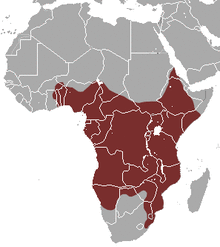| Rusty-spotted genet | |
|---|---|
_(30556229264).jpg) | |
| Scientific classification | |
| Kingdom: | Animalia |
| Phylum: | Chordata |
| Class: | Mammalia |
| Order: | Carnivora |
| Suborder: | Feliformia |
| Family: | Viverridae |
| Genus: | Genetta |
| Species: | G. maculata |
| Binomial name | |
| Genetta maculata (Gray, 1830) | |
 | |
| Rusty-spotted genet range | |
The rusty-spotted genet (Genetta maculata),[2] also called panther genet and large-spotted genet, is a genet that is widely distributed in sub-Saharan Africa. It is considered common and therefore listed as Least Concern on the IUCN Red List.[1]
Characteristics
The rusty-spotted genet has short whitish grey to pale yellow coloured fur with dark spots and a continuous dark line across the back. The spots of the upper two dorsal rows are round or square, brown in the center and darker outside. In head-to-body length it ranges from 42 to 52 cm (17 to 20 in). Its 40 to 53 cm (16 to 21 in) long tail is ringed and has a dark tip. Its feet are of the same colour as the fur. It weighs from 1.3 to 3 kg (2.9 to 6.6 lb).[3][4]
Behaviour and ecology
Research in southeastern Nigeria revealed that the rusty-spotted genet has an omnivorous diet. It feeds on rodents like giant pouched rats (Cricetomys), Nigerian shrew (Crocidura nigeriae), Temminck's mouse (Mus musculoides), Tullberg's soft-furred mouse (Praomys tulbergi), Peters's striped mouse (Hybomys univittatus), typical striped grass mouse (Lemniscomys striatus), red-eyed dove (Streptopelia semitorquata), common agama (Agama agama), Mabuya skinks, Myriapoda, spiders, Orthoptera and Coleoptera as well as eggs, fruits, berries and seeds.[5]
Taxonomy
In 1830, John Edward Gray first described a rusty-spotted genet using the name Viverra maculata based on a zoological specimen that lived in the menagerie at the Tower of London.[6] In the 19th and 20th centuries, several taxonomists proposed the following species and subspecies for specimens obtained by natural history museums:[2]
- fieldiana Du Chaillu, 1860[7]
- aequatorialis Heuglin, 1866[8]
- erlangeri, gleimi, schraderi, stuhlmanni, suahelica, zambesiana Matschie, 1902[9]
- matschiei Neumann, 1902[10]
- letabae Thomas and Schwann, 1906[11]
- pumila Hollister, 1916[12]
- insularis Cabrera, 1921[13]
- rubiginosa zuluensis Roberts, 1924[14]
- soror Schwarz, 1929[15]
- rubiginosa albiventris Roberts, 1932[16]
- deorum Funaioli and Simonetta, 1960[17]
- pardina schoutedeni Crawford-Cabral, 1970[18]
References
- ^ a b Angelici, F.M.; Gaubert, P. & Do Linh San, E. (2016). "Genetta maculata". IUCN Red List of Threatened Species. 2016: e.T41699A45218948. Retrieved 30 October 2018.
- ^ a b Wozencraft, W.C. (2005). "Genetta maculata". In Wilson, D.E.; Reeder, D.M (eds.). Mammal Species of the World: A Taxonomic and Geographic Reference (3rd ed.). Johns Hopkins University Press. p. 556. ISBN 978-0-8018-8221-0. OCLC 62265494.
- ^ Gaubert, P., Taylor, P. J., & Veron, G. (2005). Integrative taxonomy and phylogenetic systematics of the genets (Carnivora, Viverridae, Genetta): a new classification of the most speciose carnivoran genus in Africa. In: Huber, B. A., Sinclair, B. J., Lampe, K.-H. (eds.) African Biodiversity: Molecules, Organisms, Ecosystems. Proceedings of the 5th International Symposium of Tropical Biology, Museum König, Bonn. Springer. Pp. 371–383.
- ^ Foley, C., Foley, L., Lobora, A., De Luca, D., Msuha, M., Davenport, T. R., & Durant, S. M. (2014). A Field Guide to the Larger Mammals of Tanzania. Princeton University Press.
- ^ Angelici, F. M. (2000). "Food habits and resource partitioning of carnivores (Herpestidae, Viverridae) in the rainforests of southeastern Nigeria: preliminary results" (PDF). Revue d'Écologie (La Terre et la Vie). 55: 67–76.
- ^ Gray, J. E. (1830). "Fam. Felidae. Gen. Viverra". Spicilegia zoologica; or, original figures and short systematic descriptions of new and unfigured animals. London: Treüttel, Würtz. p. 9.
- ^ Du Chaillu, P. (1860). "Descriptions of five new species of mammals discovered in western equatorial Africa". Proceedings of the Boston Society of Natural History. 7 (29): 298−304.
- ^ Heuglin, T. (1866). "Genetta aequatorialis Heugl". Systematische Übersicht der Säugethiere Nordost-Afrika's mit Einschluss der arabischen Küste, des rothen Meeres, der Somáli-und der Nilquellen-Länder, südwärts bis zum vierten Grade nördlicher Breite. Wien: Kaiserliche Akademie der Wissenschaften. p. 23.
- ^ Matschie, P. (1902). "Über die individuellen und geographischen Abänderungen der Ginsterkatzen". In Matschie, P. (ed.). Verhandlungen des V. Internationalen Zoologen-Congresses. Jena: Gustav Fischer. pp. 1128–1144.
- ^ Neumann, O. R. (1902). "Über einige neue Arten der Ginsterkatzen". Sitzungsberichte der Gesellschaft Naturforschender Freunde zu Berlin. 8: 181–184.
- ^ Thomas, O. and Schwann, H. (1906). "The Rudd exploration of South Africa. − V. List of mammals obtained by Mr. Grant in North East Transvaal". Proceedings of the Zoological Society of London: 575−591.
- ^ Hollister, N. (1916). "Descriptions of a new genus and eight new species and subspecies of African mammals" (PDF). Smithsonian Miscellaneous Collections. 66: 1−8.
- ^ Cabrera, A. (1921). "Algunos carnívoros africanos nuevos". Boletín de la Real Sociedad Española de Historia Natural. 21: 261−264.
- ^ Roberts, A. (1924). "Some additions to the list of South African mammals" (PDF). Annals of the Transvaal Museum. 10 (2): 59−76.
- ^ Schwarz, E. (1929). "On two new genets from the upper Congo". Annals and Magazine of Natural History. Series 10. 3 (13): 47−48. doi:10.1080/00222932908672935.
- ^ Roberts, A. P. (1932). "reliminary description of fifty-seven new forms of South African mammals" (PDF). Annals of the Transvaal Museum. 15 (1): 1−19.
- ^ Funaioli, U. and Simonetta, A.M. (1960). "Spedizione biologica in Somalia, 1959. Risultati zoologici. Carnivora". Monitore Zoologico Italiano. 68: 58−79.
- ^ Crawford-Cabral, J. (1970). "As genetas da Africa Central". Boletim do Instituto de Investigação Científica de Angola. 7: 3–23.
